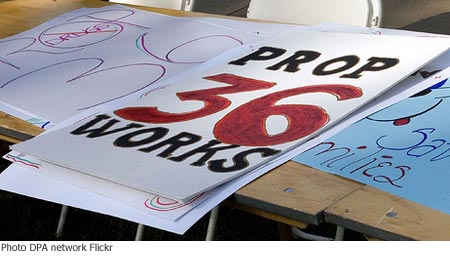Prop. 36 treatment dollars up in smoke
October 22, 2009
In theory, it was a win-win.
Nine years ago, California voters overwhelmingly approved a measure to put low-level drug offenders on a path to rehabilitation while potentially saving taxpayers huge sums in jail costs.
Proposition 36 guaranteed non-violent drug and alcohol abusers the right to enter community-based treatment programs in lieu of incarceration. Since its passage, a yearly average of more than 50,000 individuals statewide has opted for the program, more than 25% of them in L.A. County.
Today, however, the alternative-sentencing program is imperiled, a victim of California’s budget mess. State legislators, faced with a gaping deficit this summer, eliminated the measure’s $120 million budget, forcing California’s hard-pressed counties to confront the consequences.
Although the state has appropriated $18 million in other treatment monies and has held out the possibility of giving counties millions more in federal stimulus funds next year, the impact on L.A. County has been swift and severe. In late September, the Board of Supervisors was forced to sign off on a stunning 80 percent reduction in Prop. 36 treatment services.
“The law will still be on the books. People will still be looking for treatment. But the treatment won’t be there for many of them,” says Nicholas Vrataric, executive director of the Clare Foundation, a Westside treatment center.
Some of the fallout so far:
- Nineteen Prop. 36 drug courts have been shut down because of the slashed state funding. The Probation Department, for its part, is no longer assigning officers to misdemeanor offenders, who represent about 30 percent of total participants in Prop. 36 programs, or to centers where violators are assessed for the kind of treatment they need.
- The waiting list for Prop. 36 treatment is swelling and expected to hit around 5,000 by year’s end, says John Viernes Jr., director of the county Public Health Department’s Alcohol and Drug Program Administration. Until recently, it was zero.
- Weekly drug tests for Prop. 36 defendants have been cut to once every two weeks.
- County health officials have begun urging providers to offer treatment alternatives that cost far less than the residential and out-patient plans currently being used. Many treatment centers, however, say they’re not yet skilled in providing these alternatives and question their effectiveness.
From its earliest years, studies have shown that Prop. 36 has saved substantial sums in prison costs, with about a third of participants completing treatment—roughly the same rate as for people outside the criminal justice system who’ve sought treatment, according to UCLA researcher Darren Urada, principal investigator for an annual statewide study of Prop. 36. In L.A County, the completion rate is even higher, about 46 percent.
Still, many government players in the criminal justice system have dismissed the program as little more than a get-out-of-jail-free card, an ideal that has fallen far short of its promise to reduce substance abuse and recidivism.
Superior Court Judge Peter Espinoza, supervising judge of the criminal branch in Los Angeles, says that “at any given time, 57 percent of the felons eligible for Proposition 36 have a bench warrant outstanding,” indicating they aren’t reporting their progress to the court as required. “We consider it one of our least successful endeavors,” he says.
Scott Stickney, a Probation Department official, says that up to 70 percent of traditional, non-Prop. 36 defendants successfully complete treatment and probation, a much higher rate than for Prop. 36 participants. Stickney argues that the measure lacks the kinds of consequences, such as jail time, that many drug offenders need as motivation to complete treatment and probation.
The truth is that no matter what the funding levels or criticisms, Prop. 36 remains the law of the land, guaranteeing certain drug offenders a right to opt for substance abuse treatment rather than jail. And that has left the county’s public health and probation officials scrambling to stretch very scarce dollars.
Viernes, of the county’s alcohol and drug program, says one goal is to find ways to lower treatment costs, without sacrificing effectiveness, so that large numbers of Prop. 36 clients can still be accommodated. That may mean shortening residential treatments from 90 days to 60 days for some clients, he says, or sending them to cheaper outpatient programs or sober living homes, which would cost far less.
But the Clare Foundation’s Vrataric is one of many providers who worry that if treatment programs are cut too much, they might become ineffective. “I think the provider community has to push back,” he says. “In good conscience, that’s not good public policy.”
The county also is determined to try to line up other sources of funding for providers serving the Prop. 36 population.
And that’s welcomed news for providers such as Kathy Watt, director of the Van Ness Recovery House in Hollywood, which specializes in gay, lesbian, bisexual and transgender addicts. The 20-bed facility has seen its county grant money already cut from $51,000 to $9,736.
“By the end of the month, we’ll be done with the funding” she said in a mid-October interview.
To compensate for the funding drop, Watt says she and other staffers took a 20 percent pay cut and vows not to turn away clients seeking the center’s specialized treatment. “We’ll find funding somehow,” she says.













 405 bridge work causes a stink
405 bridge work causes a stink
